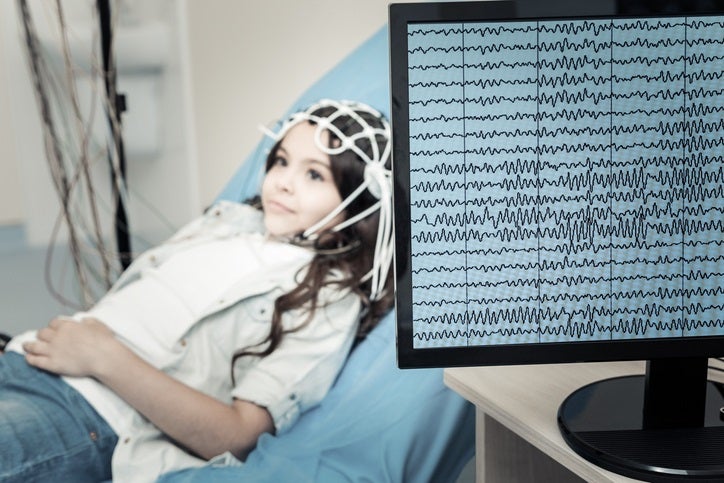EEG & LTVM Test
If you’re experiencing headaches, dizziness, seizures, confusion, stroke, loss of consciousness or have suffered a traumatic head injury, WakeMed offers a diagnostic test — an electroencephalogram (EEG) — that can give your doctor valuable information. In cases where the patient presents with seizures, there may be additional Long-Term Video Monitoring (LTVM).
An EEG test is used to record brain activity by strategically placing electrodes on a patient’s scalp. Performed as an outpatient procedure in our state-of-the-art neurodiagnostic lab, an EEG is an excellent diagnostic tool to show the effects from brain trauma, certain brain infections, brain function or loss of function in a particular region, as well as oxygen impairment to the brain.
Our team of neurodiagnostic experts collaborate to provide you whole-person care. We listen to you, answer your questions and develop a comprehensive plan suited for your individual needs.
What to Expect from an EEG Test
EEG tests can be performed as routine, sleep-deprived, ambulatory or long-term with video monitoring. After the test, we’ll release results to the referring physician, who will review them with the patient.
Routine EEG
In a routine EEG, the technologist strategically places electrodes on the patient’s scalp using a special paste. The patient may be asked to take a series of deep breaths and/or to stare briefly at a flashing bright strobe light. The patient remains awake and comfortable throughout the test but can also fall asleep. The test — including preparation, test and clean up — should take about 90 minutes.
Sleep-Deprived EEG
This test uses the same procedures for a routine EEG, except that the patient needs to be sleep deprived for a specific amount of time, based on their physician’s direction. For example, adults may be asked to stay awake after midnight or wake early for the appointment. Children may need to stay awake up to two hours after their regular bedtime and be awakened two hours earlier than normal the day of testing with no naps on the way to the appointment or before the procedure. This can be helpful in diagnosing certain conditions that impact sleep patterns.
Ambulatory EEG
This runs for a day or more, based on the physician’s direction. The technologist strategically places electrodes on the patient’s scalp using a special glue-like substance, and then wraps the patient’s head, so the patient can move around freely.
The patient returns home and will be instructed to keep a diary of events while there. Once the testing is complete, the patient returns to the neurodiagnostic lab for electrode removal and to return the diary and equipment.
Long-Term Video Monitoring (LTVM)
This test is helpful in diagnosing seizures in all age groups, especially in young patients. Here’s when the exam is typically recommended:
- Seizures are infrequent, unpredictable and subtle or the type is uncertain.
- There is uncertainty if the event is actually a seizure.
- Seizures have not responded to treatment.
- There has been a change in the child’s mental state.
In an LTVM, electrical activity in the brain is recorded using EEG wires, and the patient is videotaped. Patients will be admitted to the hospital for one or more days. Either a parent or caregiver must stay with the child during the entire hospitalization.
What to Expect if Your Child Needs an LTVM
Your child will be admitted for one or more days, as recommended by the referring physician.EEG wires will be connected to your child’s head, which will then be wrapped in gauze to help keep them in place. Each day, wires will be remotely checked and replaced if necessary.Either you or a caregiver will need to remain onsite to help with the test. The adult staying with the child will be responsible for pushing a button on the computer each time a seizure is observed or suspected. Additionally, you will keep a log of each suspected seizure, including the symptoms and start and stop time of the event.Your child must remain in view of the camera at all times but will have private access to a bathroom.You can bring books, video games, movies, school work and games that will keep your child occupied during their hospitalization, as well as your child’s most comfortable clothes/pajamas — preferably ones that button up the front, so they feel at home.You should also bring all of your child’s prescription medications and a list of past medications and doses.Activating procedures — like hyperventilation or use of strobe lights — may be performed if necessary.After the test, it’s helpful to first use baby oil on your child’s scalp prior to shampooing hair to remove any remaining glue from the electrodes.Test results will be reviewed and sent to your child’s referring physician for interpretation.
How to Find Us
Our testing is performed in our three WakeMed Neurodiagnostic Labs.
- Raleigh Campus, which is located on the 1st floor of the Medical Office Building
- Cary Hospital, 1900 Kildaire Farm Road, Cary, NC 27518, located in the Cardiopulmonary testing area
More Information and Referrals
We welcome new patients. If you’d like to receive more information about EEG and LTVM testing at WakeMed, please call us at 919-350-3734. If you are a physician referring a patient, please call us at 919-350-7000.
Raleigh
- At Outpatient Registration, turn right and follow the hall to the first intersection.
- Turn right and walk towards Mental Health and Well-Being.
- Look to the left for the elevators, and at the end of the elevator hallway, you will locate the “Neurodiagnostics” door sign.
Cary
- At Outpatient Registration, veer to the left towards Same Day Surgery. Continue left and follow the hall to the first intersection.
- Turn right and walk towards the Cardiopulmonary department.
- Neurodiagnostics is located in the Cardiopulmonary testing area.
We can also perform pediatric LTVM testing on infants and premature babies at WakeMed Children’s Hospital to gain a better understanding of brain activity.